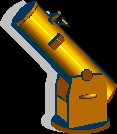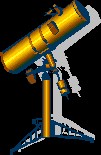Why own so Many Telescopes?
Jack Kramer
On one of the Internet astronomy groups, someone questioned why many people own two, three, four, or even more telescopes. There were several responses, so I picked a few that show various viewpoints, some in a humorous vein. Here's what they say...
Jay Reynolds Freeman"Big Iron: This is the giant Dobson-mounted Newtonian, or humungeous Schmidt-Cassegrain, that fills your garage. To transport it requires a small trailer, pickup truck, or panel van, and setting it up calls for the concerted efforts of three used fullbacks and a circus elephant. The ladder to climb to the eyepiece is so tall you need supplemental oxygen to deter altitude sickness. This telescope is your galaxy-gazer and cluster-buster supreme, and if well made, then when the seeing is good it will show detail those condescending high-tech dweebs with their confounded itty-bitty apochromatic refractors can only dream about.
Largest Conveniently Portable Telescope: This is the most telescope that will fit in your regular vehicle without hiring a bulldozer to clean it out. What it is, depends on your vehicle - with a ten-speed, or a subway train, you have a problem. An eight- to eleven-inch Schmidt-Cassegrain is just right for many; that is one reason these telescopes are popular. Public Star Party 'Scope: This is something portable, with the added provisos that it's nice to have a sidereal drive, so you won't have to re-point between viewers, and that it should not be so expensive you worry about kids and idiots. An SCT will do.
Quick Look 'Scope: The idea is to leave something set up in the entrance hall, or hidden under a stack of Sky & Tels in the car, all ready on a minute's notice if a truly close comet comes whizzing by, or if you are too lazy to assemble one of your real telescopes. Such an instrument can also double at nature watching or spying on the neighbors, which may be the same thing - but don't tell your fellow astronomers, or you will lose observer points. Many of us have a spotting 'scope on a light tripod, or a 90 mm Maksutov on a heavy one.
Binocular: A binocular can do much of what a Quick Look 'Scope does. I have too many: For astronomy I use a 7x35 Tasco (from Sears, $29.95) that I keep in my car for birding (oops, lost observer points), a Swift Commodore Mark II 7x50 (out of production), which was one of the first binoculars I saw with BAK-4 prisms, and an Orion 10x50 and 14x70 with BAK-4 prisms and multicoated everything, up to but not including the case. At star parties I wander around with a binocular dangling from my neck. I tried two, but ran out of eyes. High-Tech Conversation-Stopper: This is how you shame those grass-chewing hillbilly clodstompers whose giant cardboard Dobsons have tubes so big they echo. Odds are the seeing will never get good enough to demonstrate that a half meter shaving mirror will blow eighteen centimeters of optical perfection clean out of the water, and when they go on about faint galaxies, you can change the subject to diffraction rings and modulation transfer functions, and ask them to compare internal baffles and background sky brightness. Besides, your telescope has more knobs than all theirs put together, and it cost more than all theirs put together, too.
CyberScope: With the processor power of a microwave oven and servomechanisms accurate enough to bring an object into the field of a medium-power eyepiece, a computer-controlled telescope declares to astronomers and computer types alike the owner's level of sophistication in both disciplines. Advanced versions log observations in your own digitally simulated handwriting, brew coffee to keep themselves awake, and buy off local raccoons with Oreos, all while you sit inside at your real computer, writing space-combat video games in graphically-enhanced modularized compiled Tiny BASIC for Windows 2000 NT. The battery truck is huge."
Mike Hosea: "It makes economic sense for some people to have a 1/4 wave "light bucket" and a smaller, higher quality, planetary scope of some kind. This leads to a kind of segregation of objects for one or the other. My approach is quite different, however. My 10" Newt is very high quality as is my 6" MCT. I also have a good 80mm f/5 achromat. The way I see it, all of these scopes are for all objects, but each scope has different virtues and vices. The Newt has greater light gathering power and greater planetary resolution. In good seeing the other scopes offer no competition on any object. But it's not very comfortable to use, relatively speaking. If you move the scope 10 degrees you have to move your chair. Then there are the diffraction spikes from the spider vanes, and the intrinsic off-axis coma that limits sharpness at the edge of a wide field, especially without a Paracorr, which I could use only with much annoyance for focus and balance reasons. I'm not talking about portability when I say that sometimes I just don't feel like putting in the work of using the Newtonian.
The 6" MCT has less light gathering capability, but when seeing isn't so good, it will show almost as much as the Newt on planets, and it's so easy to just sit behind it and aim at different targets. One really only need consider about 4 different chair locations. The field is well corrected and flat, sharp from edge to edge. There are no spider vanes, and it scatters very little light. But it takes hours to cool properly in cold weather, and, like I said, it's no match for the 10" Newt in good seeing. But if I had to cash out of this hobby except for about $1500 resale value of investment, including eyepieces, I'd be happy enough with this 6" scope. I wouldn't be able to see the smallest lunar and planetary details, but I could at least follow what was going on in the solar system and observe my favorite bright DSOs from time to time.
The 80mm f/5 refractor is far inferior to both of these scopes, but I can grab it and its tripod in one hand and be observing in a few seconds. It's great for doing little Messier tours. Bright DSOs are easily detected, though there is not much detail. It makes it possible to observe sometimes when the weather is threatening to change and it seems imprudent to take out the larger scopes. Perhaps most importantly, it gives me a way of playing with my eyepieces even indoors. Ever test an eyepiece by observing the pixels on your TV screen? I have 10x50 binoculars as well, but I don't often observe for long with them because I like to be able to crank up the magnification."
Fred Parker: "It's an evolution. First, the beginner scope. Reading tells you that aperture is king so you get an outrageously large reflector of some sort. You then realize that it's useless in turbulent, light-polluted urban sites, so it becomes your "portable scope" to take to dark sites.
When you're at the dark site, having trucked 200lbs of equipment over 60 miles, the person next to you has a small, short refractor weighing maybe six pounds that he just takes out of the car, plunks down and begins observing. You look through it expecting to chuckle but fall in love instead. So now you have three scopes. Back at home you try out the wide field portable refractor and find out it doesn't quite make it for planetary views. By this time you're a little older, possibly a little richer, and "quality" of view impresses you more than raw aperture. BINGO! a mid-size APO refractor is inevitable!
Along the way you trade a lot of scopes, acquire an endless supply of accessories and a library of books and a hard drive full of software. Some folks get stuck in the cycle somewhere. There are a few over on the Refractor group that have dozens of APO refractors. At that point, you're a collector like matchbooks or seashells but on a much more "astronomical" financial plane. Personally, I think that would only confuse me. I'd spend three hours trying to decide which scope to choose until I got too sleepy to observe.
I think the main thing is to enjoy observing and let it take you where it will."
Ed Ting: "1) Your default telescope. This is the one you take with you unless circumstances dictate otherwise. It's the one you reach for, without thinking about it. My default scope is the Takahashi FS102. 8" Schmidt-Cassegrains are popular default scopes.
2) Your quick look scope. Every bit as important as your default scope, and perhaps even more so since it gets you out observing on those marginal nights. Small is the key concept here. If you can move it outdoors with one hand, all the better. My current quick look scope is the Ranger, which sometimes doubles as the default scope. The Orion Short Tube/Celestron FS80WA also make great quick look scopes.
3) A light bucket. For those nights where you want to stop goofing off and get serious. I'm a small-aperture sort of guy; my "light bucket" is the 20-year-old 6" f/8 reflector. Your luggability tolerance may be higher than mine, however, in which case you may want to spring for one of the big Dobsonians.
4) A star party/school scope. With 300 kids running around, do you really want to bring your fluorite refractor or your 98% hand-figured mirror? You'll need a scope with OK optics that won't have you seeing red if someone dumps it into the mud. I use an equatorially-mounted 60 mm Vixen refractor, or I bring the reflector.
To all of this, I would add a pair of binoculars (again, being a small-aperture kind of guy, I usually bring my Ultima 8X32's.) Some of the serious photographers in our group would add a dedicated astrophotography/CCD scope to the list. And to which I would add, your "heirloom scope". The one you know you would never part with, even if you got out of astronomy. Your heirloom scope gives you a sense of continuity, through all of your upgrades and trades.
The obvious choice for me would be the Takahashi, but lately I've had the urge to get on the waiting list for an Astro-Physics refractor."
..And finally...Mae West:: "Too much of a good thing is wonderful." (Of course, she wasn't referring to telescopes, but it just seems to fit!) - Jack Kramer









